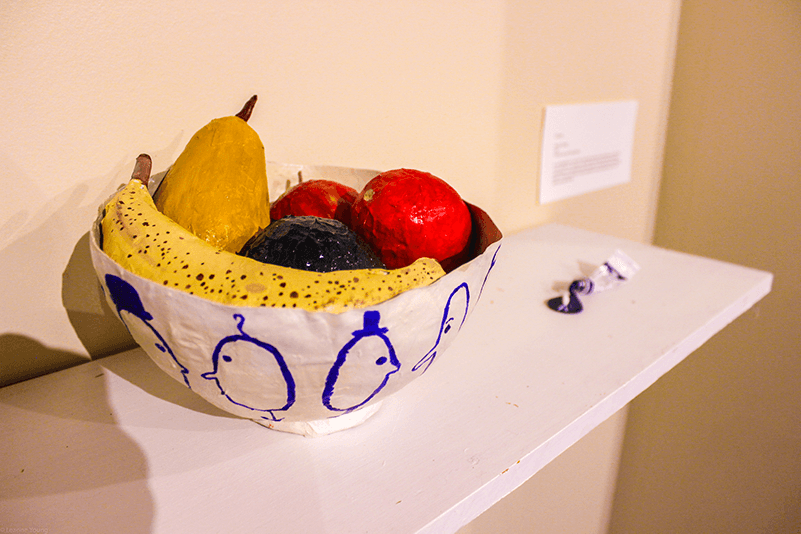A staple of the student art community on McGill campus, the Fridge Door Gallery (FDG) continuously offers high-quality programming, filling the absence of a formal fine art program. On Nov. 22, the FDG hosted their fall vernissage, In Present Tense, offering free wine, homemade bread, and art to the public. The event attracted a full crowd to the small venue, Espace 8. The FDG hosts two exhibitions each year displaying sculptures, paintings, and mixed media pieces from McGill student artists. In Present Tense was thoughtfully curated with earnest and intimate art, exploring what it means to carry the weight of the past in the present.
The theme for the exhibition was the “historical present,” a phrase often tossed around when discussing contemporary art, but one that is tricky to define. FDG’s curatorial statement describes it as the point when “our present become[s] our past—rational rather than affective.”
Rather than an exact moment, the historical present tense is a transitional relationship between the present and past that the works attempt to catch. Many of the works feature bodies depicted in relation to time: As we are constantly in the process of ‘growing up,’ our lived experience are often expressed visually or through emotion.
Grace Pooley’s tapestry-sized acrylic paintings exemplify both the decay and fullness of life through paintings of women’s bodies. In a similar sense, Maddy Holton’s mixed media piece, //stain//, shows the material impact of lived reality on the clothes we wear, adorning space and time with the experience of a stain on a shirt. As the curatorial statement reads, “These works consider what it means to be a body in time-mutable, conditioned, and conditioning.”
A standout piece from the exhibition was a photograph entitled New Jacket by Marie Saadeh. Featured on the cover of the exhibition guide, the image encompasses the historical present gracefully in a captured moment of vulnerable transience. The picture depicts an older man trying on a jacket in a thrift store, examining the jacket and his own figure in the mirror. While he inspects the jacket from the side, he turns his head as if he is hesitant to confront the image before him. The jacket represents hope and possibility, a means of self-preservation and self presentation. The framing of the photo adds to the sense of intimacy—an out-of-focus door frame surrounds three sides of the picture, yet viewers get a crystal clear view of the man’s mirror image. The mundane act of buying a new jacket at a thrift store is incorporating a piece of history into your own. New Jacket gives an intimate look into a moment full of vulnerability and possibility.
The artists’ statements were beautifully eloquent, a testament to the fact that many of the student artists are in McGill’s Department of Art History and Communication Studies. Additionally, the inclusion of each artists’ Instagram handle next to the titles reflects the present state of the art world—often, the only way to access a student’s art collection is through online display. While the works in the gallery were presented in a physical form, many of them focused on digital subject matter. Gemma Else’s watercolour selfie series not only demonstrates that selfies are modern-day portraiture, but also comments on how they are displayed. Aidan Hepburn’s still-life window scenes were originally made on digital mediums, seeing it portrayed on a scale larger than a laptop screen allowed its intricate artistry to shine through in a public setting, far away from a private desktop.
Overall, the vernissage was a delightful evening celebrating the artistic talent and passion of McGill’s student artists. Without a formal fine arts program at McGill, the FDG provides a valuable platform for promoting student creativity in a public setting.








